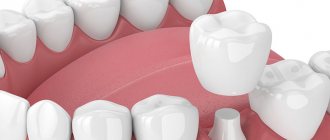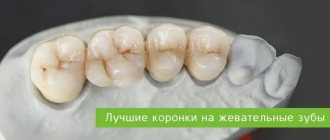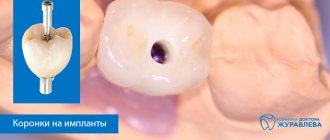Indications and contraindications
The main indication for manufacturing and installation is the implementation of the functions of permanent crowns until they are fixed. Temporary structures during the period of prosthetics, in addition to eliminating aesthetic problems, perform the following tasks:
- restore the chewing ability of ground teeth;
- prevent changes in bite - do not allow neighboring teeth to move;
- maintain diction and correct pronunciation of sounds;
- protect against infection penetration into the tissues of prepared teeth;
- prevent mechanical damage to teeth and gums;
- protect from thermal and chemical irritants if depulpation has not been performed;
- prevent gums from growing on the stump;
- allow you to get used to the permanent crown.
Since such structures are installed before permanent prosthetics, contraindications correspond to the restrictions for installing permanent crowns:
- deep bite;
- bruxism;
- allergy to crown material;
- childhood.
Temporary crowns are also installed on implants - immediately after they are implanted into the jawbone with a one-stage implantation protocol or 10-14 days before installing permanent crowns with the classical method.
What is this.
In cases of minor trauma to the enamel, chips or cracks, aesthetic restoration is used, but if the tooth is destroyed by more than half, there is only one way out - prosthetics.
To secure the crown, you must first grind down part of the enamel. After preparation, the damaged surface looks very unsightly, and to hide it, a special “cap” is put on the tooth. Temporary structures are created in a fairly short period of time, from 1 hour to a couple of days, and installed up to several months. Afterwards, they are removed, and a permanent crown is attached to this place, and this is where the regeneration procedure ends.
Materials
Temporary crowns must be strong and protect sharpened teeth well. But since they will perform their functions for a short time, the requirements for them are lower than for permanent ones. Inexpensive materials are used for manufacturing - various plastics and composites.
Plastic crowns
Plastic is easy to process, can be adjusted, is inexpensive, and provides aesthetics for a short time. Disadvantages of the material:
- due to the porous structure, bacteria accumulate;
- changes color upon contact with food or drinks;
- Due to low strength, chips and damage when chewing are possible.
Composite
Composite is a material that is used for filling teeth. Consists of organic and inorganic substances. Hardens under light, temperature or chemical influence. Just like plastic structures, they can be quickly manufactured and adjusted according to the bite. At the same time, it is more durable than plastic.
Cons of the composite:
- more expensive than crowns made of plastic materials;
- color instability when worn for a long time.
Life time.
As has already become clear, this device is intended only for a short period of use and for the purpose of replacing a cosmetic defect and restoring the functionality of the jaw. Typically, plastic products last no more than 6 months, and composite ones up to a year. Therefore, you are unlikely to be able to extend the shelf life of the “caps”, and if you do not follow the operating rules, you risk reducing it altogether. When wearing crowns for a long time, their surface wears off, which is why neighboring healthy teeth begin to shift towards the ground unit, and the aesthetics of artificial systems leaves much to be desired. It is not recommended to delay the next stage of prosthetics, and as soon as the main onlay is ready, replace it.
What to do if the crown falls out.
As mentioned earlier, the crown may fall out, this is due to a number of factors, but the main reason is the adhesive, which is prone to dissolution. Because the overlay is assigned only temporarily; a specialist cannot fix it on a permanent basis. It does not fit tightly enough to the surface of the tooth, so it can slip off. In this case, you cannot try to return it to its original place yourself using improvised means. For example, plasticine, toothpaste or household glue. Not only will you damage the crown, but you will also cause serious harm to the ground molars and incisors. If this happens to you, it is recommended to do the following:
- First, call your doctor and explain the situation, make an appointment for correction.
- If your dentist cannot help you at the moment, rinse the crown and carefully place it back in your mouth (without using any aids, of course). Even in this form, it can at least somehow protect your tooth. When eating and before going to bed, you need to put it in a glass of warm water, continue these techniques until your visit to the doctor, and if it drags on, contact another specialist.
Important! Do not ignore this problem and resolve it as soon as possible. In the worst case, the infection will get into the pulp of the tooth and it will become inflamed, which may lead to its removal.
Clinical and laboratory stages of manufacturing
Direct method - in the clinic
It takes no more than an hour. The crown is made by a doctor in the presence of the patient.
- The orthopedist takes an impression of the jaw.
- Dissects a unit.
- Forms a stump for fixing the prosthesis.
- Plastic material is poured into the impression.
- Puts the product back on the jaw.
- After hardening, an impression is taken (the material remains in the right place).
- Corrects the shape of the temporary prosthesis.
- Fixed with temporary cement.
The direct method is simple and economical. Used to restore a small number of teeth (up to 3), and not chewing ones. You should not count on high aesthetic qualities. The method is suitable if permanent dentures are planned to be installed soon.
Indirect method - in a dental laboratory
The indirect method involves production in a dental laboratory and takes up to 2 days. The products are more durable and match natural teeth in shape and color. In the laboratory, a prosthesis can be made using two technologies.
Dental technician:
- At the appointment, the doctor prepares the damaged unit and takes impressions.
- Transfers impressions to the dental laboratory.
- The dentist makes a plaster model of the cast, a prototype of the future tooth, and then casts a crown from hot-cured acrylic.
Robotic CAD/CAM technology:
- At the appointment, the orthopedist performs a CT scan.
- A model of the patient's jaw is created on a computer.
- The crown is modeled.
- The structure is polished from PMMA (thermoplastic material).
Temporary dentures made of highly structured thermoplastic material PMMA are optimal for patients with allergies to plastics and last longer.
Why are such prostheses needed - functions and purpose?
What are temporary crowns needed for, and why are they placed? The manufacture of any permanent dentures requires a certain amount of time – usually three or more days. At the same time, the supporting teeth have already passed the processing stage and do not look quite aesthetically pleasing - after all, they are quite sharply ground. Therefore, if the question arises - why are temporary crowns placed before permanent ones, you need to understand that they serve the following purposes:
- protection of the ground tooth and surrounding gums from mechanical damage: during chewing food or brushing with a toothbrush. Inflammation of the gums or dental “nerve” should not be allowed. It is also necessary to maintain the shape of the support, because the permanent “cap” is made using casts from the support – and if it breaks, you will have to start prosthetics “from scratch”
- protection from external irritants: acids, temperature changes,
- restoration of dental aesthetics,
- restoration of the functionality of the tooth: of course, in this case its “functionality” will be incomplete, because strong chewing pressure can damage the root or implant,
- acceleration of adaptation to a permanent prosthesis,
- normalization and correction of the position of the gums, if such a crown is placed on a newly installed implant.
Only until December 25 South Korean implant Osstem - from 18,500 rubles.
Hurry up to sign up for a free consultation and lock in promotional prices.
Call now or request a call
Opening hours: 24 hours a day - seven days a week
Features of installation on the front and chewing teeth
When replacing incisors or canines with prosthetics, the aesthetics of your smile is important. Only the laboratory (indirect) method of manufacturing orthopedic structures is suitable. It is necessary to pay attention to the correspondence of the color of the material and the natural enamel of neighboring units in the opposite row.
For chewing teeth, provisional dentures are only suitable for short-term replacement for a short period of time. Due to stress, they wear out and crack. If you need to wear them for a long time, it is better to order metal crowns lined with plastic.
Why do you need a “temporary” solution?
Life experience suggests that when we are offered incomprehensible solutions or there are doubts about their appropriateness, the fragile, not yet fully formed trust in a specialist, and in our case in a doctor, can be destroyed.
The fact that, in principle, without teeth is bad is clear, therefore it is advisable to restore them and, if possible, not to postpone prosthetics for a long time.
However, why make “temporary” crowns or even more complex “temporary” orthopedic structures, because they cost money, and wearing them delays the completion of treatment?
Maybe it would be better to immediately manufacture and install the desired denture?
Now we will try to explain the importance of the temporary prosthetics stage and tell you how it affects the course of treatment and the final result.
How long can you walk with a temporary crown?
Temporary prosthetics last up to 4 weeks. Wearing provisional structures beyond this period leads to adverse consequences:
- inflammation of the gums;
- carious lesions of the stump;
- tissue suppuration;
- injuries due to chips.
If the patient plans to walk longer than expected, the doctor must be informed about this in advance so that he can select long-term wearing material. You can extend the service life if you install structures whose frame is reinforced with fiberglass or metal mesh. They cost more.
How to remove a prosthesis
How are temporary crowns removed? It is worth noting that removal should only be carried out by a doctor. This procedure is painless and does not require any special preparation from the patient. But it should not be carried out by him himself. Let's look at the removal process step by step:
- the prosthesis is exposed to ultrasonic waves, from which the adhesive base begins to crumble,
- removal using a special tool (crown remover or Kopp apparatus): it has a small hook and lever,
- cement residues are removed from the support using ultrasound,
- diagnostics of the abutment tooth is carried out: for damage and inflammatory processes,
- a temporary or permanent prosthesis is installed: the choice depends on the stage of prosthetics.
Complex on 4 OSSTEM implants with delayed loading - from RUB 170,000.
Complex implantation Osstem (South Korea) with delayed loading after 4-6 months.
Guarantee for the doctor’s work - unlimited Call now or order a call
Opening hours: 24 hours a day - seven days a week
What to do if the crown falls out on its own? To avoid complications, you should put it in a clean container and contact your dentist. You cannot reinstall it yourself, otherwise you may damage the support or cause inflammation. Moreover, you should not use any adhesives not intended for the oral cavity, as well as chewing gum.
Temporary crowns on dental implants
Some patients do not understand why they should overpay for artificial teeth that will soon have to be replaced with permanent ones. But temporary prosthetics on implants is a mandatory step and is necessary for:
- Formation of the correct physiological gingival contour. Important for the aesthetics of a smile, facilitating hygiene, and preventing inflammatory gum diseases.
- Creating the correct occlusion. After a long absence, a false tooth is perceived as a foreign body - biting of the mucous membrane of the cheeks, tongue, or non-occlusion of the teeth is possible. A temporary denture helps you get used to your restored chewing abilities. Adjustment according to the bite is possible (permanent structures cannot be ground, turned, or built up).
- Avoid overloading the implant. Temporary non-rigid materials cushion and prevent excessive stress and loosening of titanium roots.
- Adaptation to new sensations and aesthetics. The patient gets used to the sensations in the mouth, a new smile, and diction normalizes. Temporary structures are adjusted taking into account the patient’s wishes, and the shape of the permanent ones is determined from them.
Advantages and disadvantages
The advantages of temporary crowns include the following:
- plasticity of the material: the “cap” can be easily modified directly in the patient’s mouth. It won't cause any discomfort.
- lightness of the design and speed of its manufacture: in just 1 hour you can “hide” a ground tooth or implant under a temporary prosthesis, which will not put strong pressure on the support and gums,
- low cost: many clinics include this price in the general price list,
- quite good aesthetics: of course, this directly depends on the material. Therefore, it is better to choose products made from composite, they look more natural and last longer,
- high-quality tooth protection from light loads,
- there is no need for special hygienic care,
- Possibility of installation with bracket systems and aligners.
Such prostheses also have disadvantages, and it is because of them that the wearing period is often reduced:
- plastic quickly darkens: under the influence of tea, coffee, etc. It is impossible to bleach it, because... the pigment penetrates deeply into the porous structure of the plastic. Therefore, plastic dentures quickly darken even with high-quality care,
- the original color of the plastic is very white: this is also a minus, since the “cap” makes other segments of the smile look unattractive,
- allergic reactions are possible: this applies to a greater extent to plastic and acrylic,
- the fixation on the support is not very tight (like permanent ones): which can lead to peeling off,
- You must adhere very strictly to dietary recommendations: you cannot eat hard foods, or very hot or cold foods. Dentists advise avoiding dark and brightly colored foods.
- short operating time.
Do I need to get temporary crowns?
Temporary prosthetics on implants allows the gums to form and allows the patient to imagine the shape of future teeth. Such designs can be adjusted and remodeled in one visit. In this way, the final prosthesis can be predicted.
Levin Dmitry Valerievich
Chief physician, Ph.D.
Determining the color of a dental crown.
This stage is of great importance for the aesthetics of the future crown ; for obvious reasons, it acquires particular importance when restoring anterior teeth. Often, working with color is limited only to viewing a standard color scale with the patient and choosing the most suitable shade. This is better than nothing, but still too little for the dental technician to create an objective visual picture. Therefore, more and more often, doctors who take aesthetics seriously are resorting to professional photographic equipment. Only photographing from different angles can give the technician maximum objective information about the basic tone of the tooth, areas of pronounced transparency, the texture of the surface of natural teeth, the presence of any natural flaws (cracks, stains, stripes, etc.)
Photographs of teeth from different angles, incl. and with standard colors (pictured on the right) allow the dental technician to see all the smallest nuances of the structure of the patient’s natural teeth. With the proper manual skills and artistic skills, this allows you to create crowns that do not differ from your own teeth even in the smallest detail...
Care
To prevent premature damage to primary teeth and additional costs, you must follow the following rules:
- brush your teeth gently, without sudden movements or excessive pressure;
- after using dental floss, remove it carefully - with two fingers, pulling the ends down;
- Avoid eating hard or sticky foods;
- minimize the chewing load on the prosthetic side;
- if the structure has shifted or been damaged, you should consult a doctor as soon as possible;
- Crowns should not be worn for longer than the period specified by the dentist.
Possible complications.
We can talk about the benefits of temporary crowns on teeth for quite a long time, but there is one caveat. Many patients note that plastic linings cause a lot of inconvenience and cause allergic reactions. This can greatly disturb a person, irritating his mucous membranes. Another unpleasant moment is inflammation of periodontal tissues. To avoid this, you need to take care of your oral health, because... plastic can absorb harmful substances.
Also, complications can develop for other reasons. Pain may be a result of an incorrect installation procedure. For example, the doctor left part of a broken instrument in the tooth canal or damaged the root. You should not delay consulting a doctor; if the source of the problem is not eliminated, the formation of cysts or purulent periostitis is possible.
Price list for orthopedic treatment
| Name of service | Price |
| Solid metal crown Crowns are made from cobalt-chrome, nickel-chrome and titanium alloys. They are durable and good for restoring the chewing function of teeth, but do not restore aesthetics. Find out which crowns are not only durable, but also aesthetic | 10000 ₽ |
| Metal-ceramic crown Crowns consist of a cast metal base and a ceramic layer applied to the metal. Metal-ceramic crowns combine the strength of metal and the aesthetics of ceramics. Learn about the pros and cons of metal-ceramic restorations | from 16500 ₽ |
| Metal-ceramic crown on an implant | from 42000 ₽ |
| Zirconium dioxide crown Ceramic-veneered zirconium dioxide crowns are both durable and beautiful. Modern materials and technologies for the production of dental crowns make it possible to abandon the choice between “Reliability” and “Beauty”. Find out what it means to choose a crown without compromise | 38500 ₽ |
| Veneer Installing veneers on your front teeth is a sure way to a flawless smile. Veneers remove the space between teeth, change the color of darkened teeth, correct the position and shape of teeth, and cover fillings and chips. If you only agree to impeccable aesthetics in the “smile zone,” choose ceramic veneers. | 27500 ₽ |
| Permanent fixation of the crown | 1000 ₽ |
| Taking an impression | 1600 ₽ |
| Temporary crown The Dental Association of Russia (STAR) recommends the use of temporary dentures as a cosmetic and functional guideline for the manufacture of permanent denture structures. What else do you need to know about temporary crowns? | 2100 — 6500 ₽ |
| Stump tab | 7000 — 8000 ₽ |
| Removable acrylic prosthesis IVOCAP | 45000 ₽ |
| Clasp prosthesis | from 48000 ₽ |
| Flexible removable denture Acry Free Whatever opportunities modern dental implantation provides, there are patients who, for various reasons, cannot take advantage of this prosthetic technology. The Acryfree® material developed by the Israeli company Perflex makes it possible to produce aesthetic removable dentures that are completely biocompatible and do not contain components that cause allergic reactions. | from 42000 ₽ |
The role of “temporary solutions” in the case of dental implantation
If one or more teeth have been missing for a long time, and also if the tooth was deliberately “removed from the bite” in order to reduce the load until it is restored, the task of the temporary restoration is “to load the teeth and help them remember their function.” In this way, the correct distribution of the chewing load is restored and the functioning of the entire dental system is improved.
Temporary restorations, made from softer materials than permanent ones, prevent injury to the teeth until the doctor selects their ideal closure.
During this period, the shape of the teeth being restored is corrected and it is easier and cheaper to do this with a temporary restoration. A correctly selected tooth shape prevents accelerated abrasion and chipping, both on the restored tooth and on opposing teeth.
Inaccuracies in the anatomical shape can not only cause discomfort to the patient and lead to chips of the enamel, but in the future cause diseases of the temporomandibular joint if it does not adapt to the new bite.
Another important task of temporary restoration, especially when it comes to restoring a missing tooth with an implant, is creating the correct gingival contour around the future permanent crown.
Temporary crowns allow you to create a beautiful and natural gum contour in place of a lost tooth.
Why else are temporary crowns needed if the tooth is restored with an implant?
For example, in order not to leave empty space in the dentition, because this can lead to the displacement of adjacent teeth and antagonist teeth.
Now you know almost everything “why” an orthopedic doctor may recommend the temporary prosthetics stage.
Of course, temporary restorations are not used in all cases, but this will be known during the consultation after examination and diagnosis.











